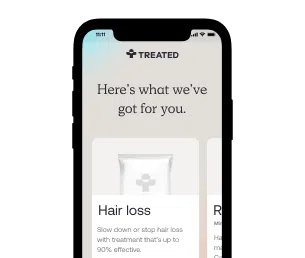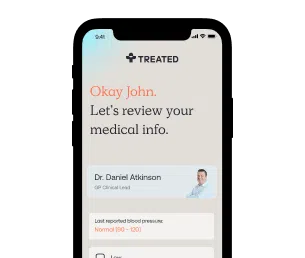Paronychia
Get effective relief for your nail infection.
Secure delivery
UK clinicians
Paronychia is a painful skin infection that you get around your fingernails and toenails. It can cause swelling and discomfort, but with our tailored treatments and expert aftercare, you can get effective relief for your symptoms.
Talk to us about your health and order paronychia treatment online.
Paronychia is an infection of the skin around your finger or toenails, which is caused by either a bacteria or a fungus. It can vary in severity, but it’s often swollen and painful. There are two types of paronychia:
The infection usually affects the skin at the bottom (cuticle) and side of your nail. It can happen to anyone at any age, and it isn’t usually serious but often needs treatment to clear up the infection. As with other types of infection, it can worsen or spread.
Paronychia is similar to another condition called herpetic whitlow (or whitlow finger), and as a result these conditions can sometimes be misdiagnosed or mistaken for one another.
Anyone of any age can get paronychia, but it’s more likely if your fingers or toes are exposed to irritation and bacteria.
There are some factors that can make a paronychia infection more likely to happen around your fingers or toes:
Paronychia is more common in adult women and people who have diabetes. People with a weakened immune system, such as people taking medicine after a transplant, or people with HIV, are more at risk of getting paronychia.
It’s not known exactly how common paronychia is, but it’s a relatively common skin and nail condition that’s easy to treat, and it’s believed to be around three times more common in women than in men.

How we source info.
When we present you with stats, data, opinion or a consensus, we’ll tell you where this came from. And we’ll only present data as clinically reliable if it’s come from a reputable source, such as a state or government-funded health body, a peer-reviewed medical journal, or a recognised analytics or data body. Read more in our editorial policy.
Paronychia is usually caused by a bacterial infection, but it can also be caused by yeast, fungal infections, and irritants. Some viruses can also cause warts around your nails, irritating your skin. If your skin is already sore or irritated, the risk of you developing paronychia becomes more likely.
Paronychia caused by bacteria can get worse quickly, whereas paronychia caused by a fungal infection usually gets worse over time.
The symptoms of paronychia are pretty typical of an infection and can appear on your nail fold and underneath your cuticles (the area of skin next to and underneath your nails).
These symptoms include:
The symptoms are usually on one nail, but if it’s caused by underlying health issues, or lifestyle or occupational factors like constant exposure to water or chemicals, then you might see symptoms on more than one finger or toe.
If paronychia is left untreated, or there’s a prolonged infection or severe infection, then the nail itself can become infected and painful. Not treating paronychia also comes with a slight risk of the infection spreading to other areas and even the loss of your nail.
Some types of paronychia can keep coming back without treatment, so the painful symptoms associated with the infection can be a regular occurrence. In extremely severe cases of infection, there can be permanent damage to tendons in the hand or foot. But this is quite rare.

How we source info.
When we present you with stats, data, opinion or a consensus, we’ll tell you where this came from. And we’ll only present data as clinically reliable if it’s come from a reputable source, such as a state or government-funded health body, a peer-reviewed medical journal, or a recognised analytics or data body. Read more in our editorial policy.
Paronychia is often treated with fusidic acid, a topical antibiotic that’s commonly used to clear up skin and eye infections. It’s also available as an oral treatment, either as a tablet or liquid, or as an injection. But a topical cream or ointment is far more common for mild skin infections like paronychia.
Fusidic acid is only available with a prescription, so you’ll need a diagnosis and prescription from our clinician before you can use it as a treatment.
Fusidic acid is one of the most common treatments for paronychia, as it’s usually quite effective and well-tolerated. But along with this, you’ll still need to practice good hygiene and try to keep the infected area clean, dry and free from irritation.
If your paronychia is painful or causing you discomfort, over-the-counter pain relief like paracetamol can help. It’s also best not to bother your nail or skin too much and to remove any artificial nails if you’re wearing them.
If there’s a lot of pus, an abcess, or a severe infection, then your clinician may recommend that it’s drained before treating it. This involves making a small incision to release the pus from the inflamed area. This can also provide relief from some of the pain and swelling.
When paronychia is very mild, it can sometimes go away on its own (especially if you’re taking steps to help it heal) but this usually means you’ll experience some pain and discomfort.
There’s always the risk of the infection becoming more severe or lasting a long time. This can lead to damage to your skin and bones, and if you have other health conditions it can become more serious.
If your infection is severe or lasts a long time, you may need antibiotics to prevent it from spreading and recurring. Paronychia can lead to stronger infections that can be really bad for your health.

How we source info.
When we present you with stats, data, opinion or a consensus, we’ll tell you where this came from. And we’ll only present data as clinically reliable if it’s come from a reputable source, such as a state or government-funded health body, a peer-reviewed medical journal, or a recognised analytics or data body. Read more in our editorial policy.
Have something specific you want to know? Search our info below, or ask our experts a question if you can’t find what you’re looking for.
Multiple herpetic whitlow lesions in a 4-year-old girl: case report and review of the literature. European Journal of Pediatrics, [online] 160(9), pp.528–533. [Accessed 2 Dec. 2021].
Paronychia - acute: How common is it? [online]. [Accessed 2 Dec. 2021].

Versatile topical antibiotic for paronychia, infected eczema, folliculitis, impetigo and psoriasis.

Registered with GMC (No. 4624794)
Meet Daniel
Registered with GPhC (No. 2202465)
Meet Sanjeda
Registered with GPhC (No. 2070724)
Meet Craig
Always read the leaflet that comes with your medication and tell us about any side effects you get.
We know health, but you know you.
Our experts tell you what’s safe, but you decide what’s best.
Answer a few questions and tell us about yourself. Get tailored advice from our clinicians so you can choose better.

Choose your treatment and how often you have it delivered.

We know things change. It’s the nature of life. We’ll check in regularly to make sure your treatment is still right for you.
Pause. Change. Skip. Start again. Any time you like.
Here are some other things we can help with.
Choose from our range of tablets and solutions. Get ongoing care and support from our experts.
Stop smoking treatments that can help you kick the habit forever, and reduce your risk of disease.
Tablets or injections. Tailored weight loss treatments combined with ongoing support from our experts.
We're making healthcare more about you. Sign up to our newsletter for personalised health articles that make a difference.
Disclaimer: The information provided on this page is not a substitute for professional medical advice, diagnosis, or treatment. If you have any questions or concerns about your health, please talk to a doctor.
We couldn't find what you're looking for.
Here's everything we treat. Or, if you're looking for something we don't have yet, you can suggest something.
If there’s a particular treatment or condition you’re looking for, tell us and we’ll look into it for you.
Submit your question here, or tell us if you’ve found an issue on our site.
We’ll get back to you very soon. We aim to respond to all queries in one working day.
You’re signed up to our newsletter. Keep an eye on your inbox for our latest update.
By clicking 'Subscribe now' you're agreeing to our Privacy Policy.
We’ve sent you an email asking you to confirm your email address.